In an effort to help my children understand more about their own heritage, I have searched far and wide for books by or about Somali immigrants or refugees. Here are some of the best ones we have found. Though a number of these titles have not been written by Somalis, they have at least been informed by input from members of this community.
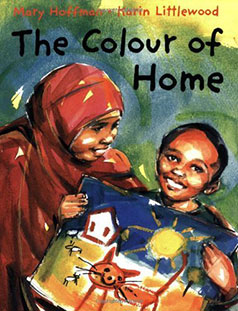 |
The Colour of Home For ages 5 to 8, The Colour of Home shares the story of Hassan, a young Somali who had recently arrived in a cold, gray, unfamiliar country. At school Hassan painted a picture of the home he missed, complete with a bright blue sky, all the members of his family, their sheep and goats, and this cat. His teacher complimented his work, but then Hassan made the sky dark, and added a man with a gun and blotches of red on the walls of their home. He smudged out one of the family members. Hassan’s teacher arranged for a translator to help him share more about his painting with his teacher. With a hopeful ending, the story offers a sensitive treatment of a difficult subject and hints at the powerful role art can play in helping children heal from trauma. It personalizes the tragedy of families having to leave their homes in order to survive, a narrative too-often replayed in various countries around the world. |
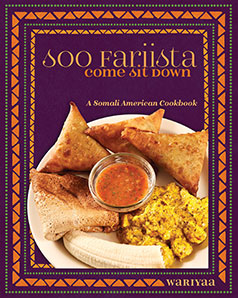 |
Come Sit Down (Soo Fariista) Nine high school students who participated in the Somali Youth in Museums program developed this Somali American cookbook as “an invitation to get to know us through our stories about our lives, our families, and our kitchens.” Students interviewed family members and tested recipes as they set out to preserve their culinary legacy. The happy result is a book of seventy recipes, accessible to those in the middle grades and above. The book opens with a brief introduction to Somali culture and history as well as information about the Somali diaspora. Many of the recipes are quite authentic, though others have been adapted based on “American realities.” Most of the recipes are easy to make, though a few of them lack the level of specificity needed to successfully complete the recipe, unless you have prior knowledge of the cuisine. If you and your kids want to try one dish from this book, choose the aromatic rice (page 134). It’s the real deal — but you’ll probably want to cut the recipe in half at least, unless you’re having a party. |
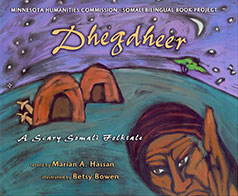 |
Dhegdeer, a Scary Somali Folktale The most well-known story from Somali folklore, the tale of Dhegdheer, has traditionally been used to scare children into good behavior. Dhegdheer is a cannibal with a long pointy ear and exceptionally good hearing. In fact, she can “hear even the gait of camels a half-day’s journey away.” Hassan’s version of this story has been toned down somewhat to make it a little less scary, but the illustrations may be a bit much for young children with strong imaginations. Still, good wins over evil, and the book touches on the theme of universal justice at work in the world. This is one of four bilingual books in the Minnesota Humanities Commission’s Somali Bilingual Book Project, most suitable for ages 5 to 8 years. A downloadable PDF of the book is available from The Minnesota Humanities Center. |
|
|
From Somalia, with Love This young adult novel begins with 14-year-old Safia learning that her father, from whom she had been separated for over a decade due to the Somali civil war, is coming to join his family in East London. Rather than feeling joyful, like her mother and oldest brother, Safia is anxious. How would things change when she’s reunited with the father she doesn’t know? Many of the questions and doubts that emerge in this fictional account will resonate with nearly anyone who has ever had concerns about fitting in among peers (most of us). Though classic elements of the immigrant experience are contained in the narrative, there are added layers of challenge because outward appearance prevents Safia from easily blending in with the host culture. The mother in the story astutely describes how many Somali immigrants feel when she states, “Now, we live in Britain, Canada, America, Holland, and we look at our children and we see strangers. We don’t understand the ways of these countries; they are not our ways…” Her daughter summarizes the feeling of the next generation when she replies, “But we’re the ones who have to live here…We’re the ones who have to find who we are…and it’s hard to be different all the time, it’s hard to feel like you don’t belong anywhere.” |
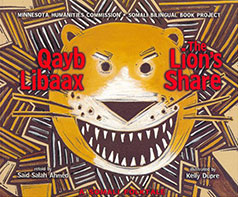 |
The Lion’s Share In this fable about the misuse of power, the lion demands a share of food he didn’t even help capture. The other animals learn that the lion is not one with whom they can argue, so they give in to his demands, all the while chanting, “The lion’s share is not fair.” This is one of four bilingual books in the Minnesota Humanities Commission’s Somali Bilingual Book Project, most suitable for ages 5 to 8 years. A downloadable PDF of the book is available. |
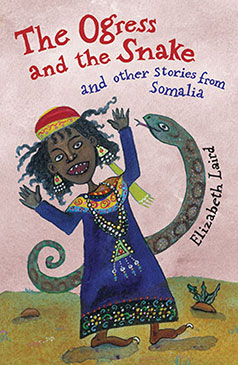 |
The Ogress and the Snake Author Elizabeth Laird aptly calls the creation of this book a “story-collecting project.” Accompanied by a translator, Laird travelled to the Somali region of Ethiopia to hear the stories first hand, in their original context, and then produced this 97-page book. It is probably one of the best collection of Somali folktales in print. After reading the book together as a family, we have come to incorporate references to several of the characters into our family discourse, most notably Daya Ali, the tricky fox, and two underhanded shopkeepers, Slippery Hirsi and Crooked Kabaalaf, who were both outsmarted as they attempted to outsmart each other. Any of the stories in this middle-grades collection would be a fun read-aloud, revealing aspects of Somali culture and values while entertaining listeners. |
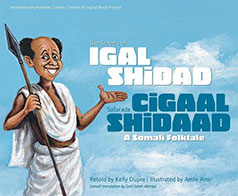 |
The Travels of Igal Shidad A nomadic herder, Igal Shidad roamed the land in order to find water and grass for his camels and sheep. Among the Somali people, Igal Shidad is known as a wise coward. In this story, his fear turns out to be unfounded — he’s afraid of a lion that turns out to be only a tree stump. In the end, he’s able to shrug off his mistake, thankful that his prayers had been answered. This is one of four bilingual books in the Minnesota Humanities Commission’s Somali Bilingual Book Project, most suitable for ages 5 to 8 years. A downloadable PDF of the book is available. |
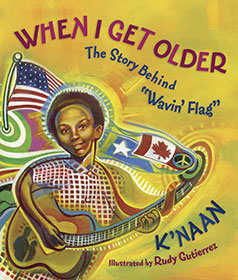 |
When I Get Older: the Story Behind “Wavin’ Flag” Songwriter and hip-hop artist K’naan wrote an autobiographical story about having to leave Somalia at 13 years of age because civil war had broken out. His grandfather, who stayed behind in their home country, had given the boy a poem of hope before they were separated: “When I get older, I will be stronger. They’ll call me freedom, just like a waving flag.” This is the poem the boy hung on to while he stayed with his uncle in Harlem and then when he and his family settled in Toronto, Canada. K’naan described some of the difficulties he encountered living in a new land, but he also showed how his poem set to music helped bridge the differences between him and his classmates. This song, “Wavin’ Flag,” was selected as the anthem of the 2010 FIFA World Cup. (Consider listening to the song after reading this picture book.) |
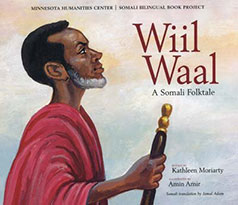 |
Wiil Waal: A Somali Folktale Wiil Waal is a folktale truly rooted in nomadic Somali culture. Some of the details, such as the symbolism of a sheep’s gullet as something that can divide or unite people, may be lost on the average Western reader. What is clear in the story, however, is that the daughter of a poor shepherd advances to a leadership position because of her wisdom and her father’s choice to trust in that wisdom. This is one of four bilingual books in the Minnesota Humanities Commission’s Somali Bilingual Book Project, most suitable for ages 5 to 8 years. A downloadable PDF of the book is available. |

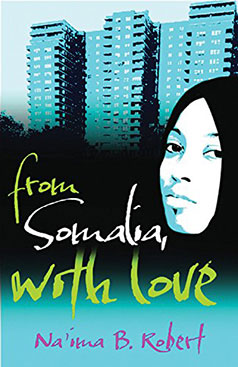
Another great book is When Stars Are Scattered by Victoria Jamieson and Omar Mohamed. Set in Dadaab, a refugee camp in Kenya, this graphic novel chronicles the harsh but also hopeful day-to-day reality of life for a boy who has fled his homeland. Just today a refugee from another continent told me how relatable she found the story. Dial Books for Young Readers, 2020.